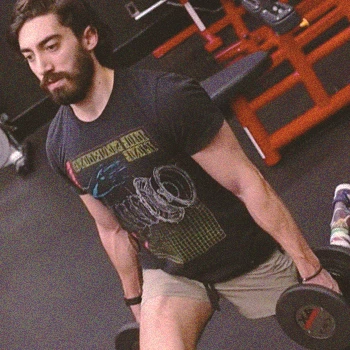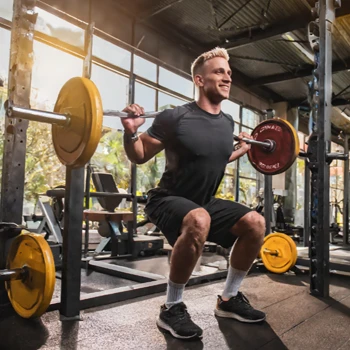Jeff Cavaliere, the creator of Athlean X, offers various exercise and diet programs tailored to different goals and fitness levels. A typical workout split in Athlean X programs is push-pull-legs (PPL).
As a trainer, any program that takes the fitness world by storm grabs my attention, so I decided to dig into the world of Athlean X and look at its PPL split.
Read on to discover how the Athlean X PPL split can help you optimize your training for maximum results.
What is Athlean X’s Workout Split?

Athlean X’s workout split is the PPL (push, pull, and leg). Jeff Cavaliere, former NY Mets head physical therapist, popularized the PPL split.
I have found from using this training approach that it offers a well-rounded and effective way to work different muscle groups.
You can perform this split once or twice a week for three or six workout days per week:
- Day 1: Push: The push workout focuses on exercises that target the shoulders, chest, and triceps.
- Day 2: Pull: The pull workout has exercises for targeting the back, biceps, and rear shoulders.
- Day 3: Legs: The leg workout focuses on exercises targeting the quads, hamstrings, glutes, and calves.
Consider incorporating a high-quality protein powder into your nutrition plan to support your progress further.
What is a Training Split?

According to a study published by the National Institutes of Health (NIH), a training split is the organization of an exercise routine where users divide training sessions into different days based on specific muscles or movement patterns [1].
There are various workout splits, and your goals, experience level, and availability will greatly influence your choice. Other than PPL, common training splits include:
- Full-body workouts: Training all major muscles in a single session, 2-4 times weekly.
- Upper-lower split: Dividing training sessions into upper-body and lower-body days. You complete this split 2-4 times weekly, alternating between upper and lower body workouts.
- Body part split (bro split): Focusing on a single muscle group or two per session. This split usually involves working out 4-6 times weekly, with each group trained once per week.
This approach to training allows for adequate rest and recovery while maintaining a consistent training schedule and muscle gains.
Push-Pull-Leg Split by Jeff Cavaliere

Pull Day One
- Barbell deadlift (80% of 1RM): 1 x 5, 4 warm up, ramp up
- Chest-supported rows: 3 x 10-12
- Dumbbell lat pullover: 2-3 x 10-12
- Dumbbell high pulls: 3 x 10-12
- Biceps chin curls: 3 x to failure
- Overhead tricep extensions: 3 x 10-12
- Angels and devils: 3 x 15-20
Push Day One
- Barbell bench press: 4 x 4-6
- High-to-low cross-over: 3 x 10-12
- Dumbbell shoulder press: 4 x 8-10
- Dumbbell 1 ½ side lateral: 3 x 12-15
- Dumbbell triceps extension: 3 x 10-12
- Dumbbell waiter curls: 3 x 10-12
- Rotator cuff external rotation: 3 x 15-20
Also read: Jeff Nippard Push Workout Routine
Leg Day One

- Barbell squat: 4 x 4-6
- Barbell hip thrust: 3 x 8-10
- Barbell or DB alternating reverse lunges: 2-3 x 10-12 each leg
- DB single-leg RDL: 3 x 10-12 each leg
- Slick floor bridge curls: 3 x to failure
- Standing DB calf raises: 3 x 15-20
- Seated DB calf raises: 3 x 15-20
Pull Day Two
- Snatch-grip deadlift: 3 x 5
- Weighted pull-up: 3 x 6-8
- Alt. dumbbell gorilla row: 3 x 10-12
- Straight-arm pushdown: 2-3 x 12-15
- Barbell / EZ curl: 3 x 6-8
- Triceps pushdown: 3 x 10-12
- Face pull: 3 x 15-20
Push Day Two

- Barbell OHP: 4 x 4-6
- Underhand dumbbell chest press: 3 x 8-10
- Dumbbell abduction rows: 3 x 8-10
- Floor flys: 10 reps, three sets
- Close grip bench press: 3 x 6-8
- Dumbbell curl (choice): 3 x 10-12
- Push-up plus: 3 x to failure
Leg Day Two
- Barbell squat: 4 x 4-6
- Barbell hip thrust: 3 x 8-10
- Barbell or DB alternating reverse lunges: 2-3 x 10-12 each leg
- DB single-leg RDL: 3 x 10-12 each leg
- Slick floor bridge curls: 3 x to failure
- Standing DB calf raises: 3 x 15-20
- Seated DB calf raises: 3 x 15-20
“Just like with every ATHLEAN-X workout, I want you to focus on quality, NOT quantity, especially if you’re doing the six-day splits”
- Jeff Cavaliere, MSPT, Athlean X
PPL Split Training Schedule
You have a couple of options when determining your schedule. You have to complete this split in one of two ways:
- Synchronous split: Train for six consecutive days followed by one rest day.
- Asynchronous split: Train for three straight days, one rest day, and three more consecutive training days.
Benefits of the Jeff Cavaliere PPL Training Split

PPL splits provide many benefits other than building muscle.
They include:
- Balanced muscle development: PPL splits divide workouts based on primary ensuring a balanced approach to training all major muscle groups.
- Adequate recovery: By cycling through push, pull, and leg days, PPL splits allow each muscle group to rest and recover while you train other muscle groups.
- Time efficiency: PPL splits can be performed 3-6 times weekly, depending on your schedule and recovery capacity making it an efficient option for those with limited time.
- Customization: You can tailor PPL splits to individual goals, experience levels, and preferences. You can modify the exercises, rep ranges, and intensity to suit your needs.
- Reduced risk of injury: By separating pushing and pulling movements, PPL splits can help reduce the risk of injury by allowing for a more balanced development of muscle groups, helping maintain joint stability.
Related Article: Chris Bumstead Push Pull Legs Routine
References:
- www.ncbi.nlm.nih.gov/pmc/articles/PMC8372753/
About The Author
You May Also Like






